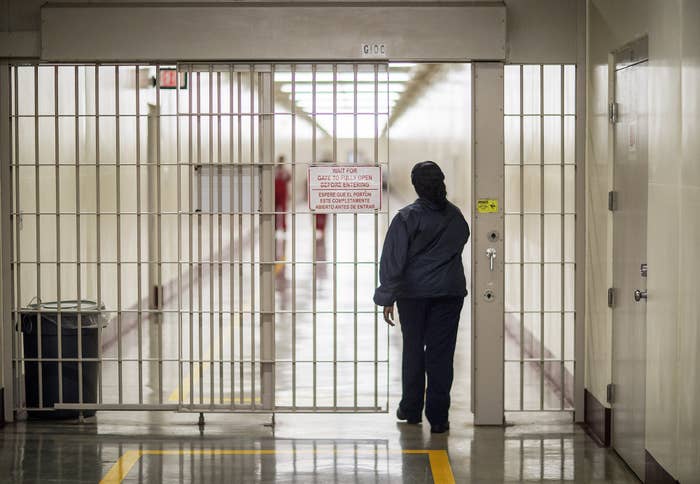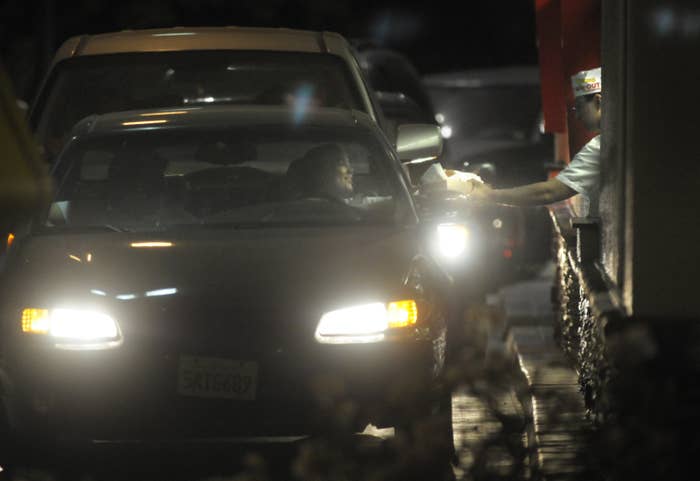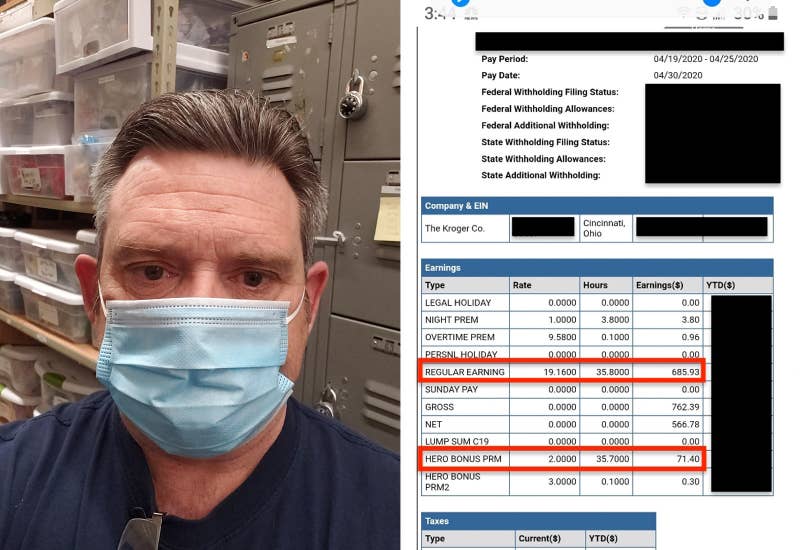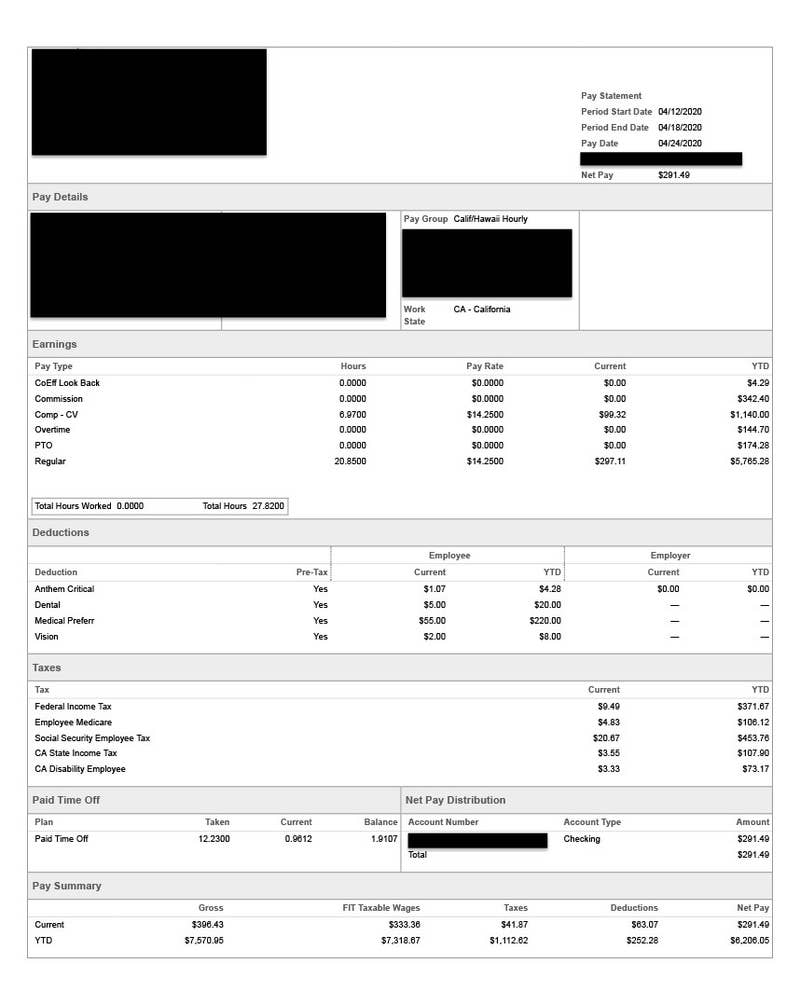Bill Gates Conspiracy Theories Have Circulated For Years. It Took The Coronavirus Pandemic To Turn Him Into A Fake Villain.
After months of conspiracy-mongering, people around the world are demanding Gates be arrested for crimes against humanity. Here’s how things got so bad.

BuzzFeed News; AP Images
On May 14, Italian politician Sara Cunial uploaded a video to her Facebook profile calling former Microsoft CEO Bill Gates a criminal and demanding he be tried for crimes against humanity.
It was a speech she made in the Italian Parliament in early May, in which Cunial, who represents a district in northern Italy, claimed Gates was developing a vaccine for COVID-19 to enslave the world’s population.
“The real goal of all of this is total control,” Cunial said, “absolute domination of human beings, transformed into guinea pigs and slaves, violating sovereignty and free will. All this thanks to tricks disguised as political compromises.
Cunial’s speech has been viewed on her page over 500,000 times and shared 30,000 times, and it’s been uploaded to countless other pages on Facebook and YouTube channels. Despite Facebook’s third-party fact-checkers marking the video “partly false," one version of it has been watched almost 1 million times.
Cunial is wrong about Gates using a vaccine for COVID-19 to commit genocide — but she is far from alone in believing it.
The online campaign against him encompasses a myriad of alternate realities created by anxious and isolated social media users, including debunked claims about 5G cellular technology, anti-vaccination rhetoric, QAnon content, and the conspiracy theory du jour, like the idea that sunlight can kill the coronavirus. And it's not just limited to the fringe: According to a Yahoo News/YouGov poll released Friday, 44% of Republicans in the US believe that Gates plans to use a COVID-19 vaccination as a way to implant microchips in people and monitor their movements.
“We’re concerned about the conspiracy theories being spread online and the damage they could cause to public health,” Mark Suzman, CEO of the Bill & Melinda Gates Foundation, told BuzzFeed News. “At a time like this, when the world is facing an unprecedented health and economic crisis, it’s distressing that there are people spreading misinformation when we should all be looking for ways to collaborate and save lives. Right now, one of the best things we can do to stop the spread of COVID-19 is spread the facts.”
There’s little chance Gates will be arrested by the Italian government — he lives in Washington state, for one — but the backlash against him reflects a very real and dangerous refusal to accept a COVID-19 vaccine if one were to become available. Even before the pandemic, between 10% and 22% of people in countries across Europe didn’t trust that vaccines were safe.
The paranoia around the former Microsoft CEO has been building for months, festering in Facebook Groups and YouTube comment sections. Here’s how the conspiracy theorists, panicked and ignorant people, and technology platforms that allowed the hoaxes to grow turned Bill Gates into the villain of the coronavirus pandemic.
The most popular version of the rumor stems from a tabloid in Ghana.
In 2010, a former staffer with a government health initiative in Ghana claimed that a community health initiative, partially funded by the Gates Foundation, had tested the contraceptive Depo-Provera on unsuspecting villagers in Navrongo, a remote town in the country, as part of an illicit “population experiment.”
The woman making the charge, Mame-Yaa Bosumtwi, was the Ghanian-born, US-educated communications officer for a separate Gates-funded initiative by the Ghanaian government and Columbia University. The program used cellphones to improve healthcare access for women and children in rural areas. Bosumtwi had clashed with another team member, James Phillips, a demographer at Columbia University's Mailman School of Public Health; when her contract was not renewed, she took her professional gripes with Phillips to the Ghanaian press and filed a lawsuit against Columbia for millions of dollars in damages.
After the lawsuit was dismissed, Bosumtwi went back to the press with a much more shocking claim: Without evidence, she said that Phillips's project in rural Ghana had experimented with Depo-Provera on women as a test run for a broader population control campaign. Patients had been abused. Some had died.
Wanted posters with Phillips’s face sprouted across the country. Protesters mobilized outside Columbia’s research center in Navrongo. Ghanaian health officials called her claims libel, and community leaders and women from the rural area condemned them as false. But death threats escalated so badly that two members of Phillips's team had to be evacuated across the border to Burkina Faso.
As Bosumtwi’s allegations of Gates-funded genocide were spreading throughout Ghana, in 2011 a women's rights group in the US called the Rebecca Project for Human Rights published a report titled "Non-Consensual Research in Africa: The Outsourcing of Tuskegee." The report claimed, without evidence, that unethical medical experiments had been undertaken by US researchers in Africa — focusing on Phillips.
“Researchers allegedly injected thousands of impoverished and illiterate Ghanaian women with a Pfizer contraceptive, Depo-Provera, and administered other unidentified oral contraceptives during human research experiments to reduce population and modify health care," the report read.
The report was written by Kwame Fosu, the Rebecca Project’s chief financial officer and policy director. The Italian-born son of Ghanaian diplomats, Fosu left out a key detail — that he was the father of Bosumtwi’s child. Although that connection might have undermined his credibility if it were made public, in 2013 Fosu released a second report, titled "Depo-Provera: Deadly Reproductive Violence Against Women." The report claimed a massive conspiracy involving international organizations — including the Gates Foundation, the United States Agency for International Development, the UN Population Fund, and Pfizer — had pushed a dangerous contraceptive on black women living in poverty in African countries.
"Melinda Gates announces her four-billion dollar contraceptive strategy featuring Depo-Provera as the optimum choice for women of color,” Fosu wrote. “These beautiful females, oblivious that they are being insidiously exploited as diversionary cynical props to mask Gates' egregious intent, are in an unprecedented Depo-Provera campaign with serious racist implications to prevent their very births."
In the US, Fosu’s white papers circulated among right-wing groups that claimed “abortion was a form of black genocide." And they had an impact within Africa as well. In 2014, Zimbabwe’s registrar general, Tobaiwa Mudede, warned women to avoid contraceptives because they were a Western ploy to limit the continent's population. That same year in Kenya, all 27 members of the nation’s Conference of Catholic Bishops declared a World Health Organization–UNICEF campaign to administer neonatal tetanus vaccines to pregnant women “a disguised population control program.”
In the years that followed, the allegations of a Gates Foundation–led black genocide in Africa may have subsided, but the conspiracy theory that Gates could be using vaccines to depopulate the planet has stuck around.
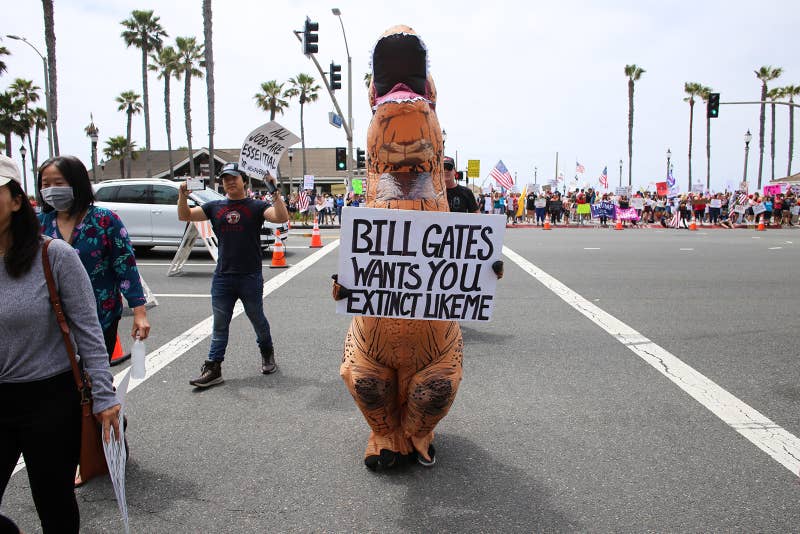
Sopa Images / Getty Images
A protester wearing a dinosaur costume holds a placard that says "Bill Gates Wants You Extinct Like Me" during a demonstration in Huntington Beach, California.
At their core, these conspiracy theories revolve around the idea that Gates is using his wealth to control the planet. As old as baseless claims that the Illuminati or the Freemasons control the world and as new as the digital revolution, they blend imaginary concerns about the hidden masters of the world and basic misunderstandings of science.
Named for the Microsoft cofounder and his wife, the Bill & Melinda Gates Foundation was launched in 2000 and is the largest private foundation in the world. In 2008, Gates transitioned out of his role with Microsoft to give himself more time to its programs and grants, which primarily focus on enhancing healthcare, reducing extreme poverty, and expanding educational opportunities and access to information technology.
While it’s completely false to say the Gates Foundation is trying to depopulate the planet, the work the foundation does is in fact influenced by overpopulation concerns popularized in the ’60s and ’70s. Gates himself has publicly acknowledged several times over the last decade his debt to the work of biologist Paul R. Ehrlich, whose 1968 book The Population Bomb brought the concept of global overpopulation into the public consciousness and was mentioned in the Gates Foundation’s annual letter in 2012.
Gates wrote about Ehrlich again in 2013, calling him “the country’s, and perhaps the world’s, most prominent environmental Cassandra" and lauding his work, even if the foundation's cofounder concluded it was too fatalistic:
“We know now that Ehrlich was extremely wrong and that following his scientific certainties would have been terrible for the poor."
So while Gates is not spending his retirement trying to commit eugenics on a global scale and is in fact actively opposed to the wing of the environmentalist movement that advocates for such a thing, it’s a connection that has been hard to shake. Spend enough time in online fever swamps and you’ll start seeing the same words over and over again — “Bill Gates,” “population control” — skipping right over the fact that Gates is against the idea.
Gates has remained a popular target for those with attenuated ties to reality. In 2016, Infowars connected him to a conspiracy theory that Zika fever could be a bioweapon. In 2018, Infowars wrote that Gates was “indirectly responsible for both Ebola and Zika outbreaks'' and was planning a global pandemic known as “Disease X.” The same year, conspiracy theory site NewsPunch published an article with the headline “Bill Gates Admits ‘Vaccines Are Best Way to Depopulate,’” which went viral enough for fact-checking site Snopes to debunk it. Conspiracies about Gates have proliferated on Facebook and YouTube as well. In January 2019, a now-debunked and -deleted article from Transcend International, a nonprofit media outlet, went viral, claiming Gates believed vaccines were too dangerous to give to his own children.
These claims have often taken a political valence: In 2018, footage leaked of Gates mocking President Donald Trump for not knowing the difference between HPV and HIV. But beyond partisanship, Gates — with his tech-made money and philanthropic efforts to improve public health — has become an avatar of populist rage at those who possess technical fluency, an elite education, and well-stamped passports.
The first rumor connecting Gates to COVID-19 was spread at the very beginning of the outbreak by QAnon YouTuber Jordan Sather. In January, when the virus was still localized in Wuhan, China, Sather claimed that the novel coronavirus was a “new fad disease” that had been “planned" by Gates.
The QAnon community believes Trump is waging a secret war against a deep state, secret messages about which are leaked out on anonymous online message boards like 8chan by an insider with “Q-level” security clearance. Gates and other wealthy liberals like George Soros are believed to be part of a global cabal of Satanists who secretly control the world.
The crux of Sather’s conspiracy hinged on a 2015 patent filed by the Pirbright Institute in Surrey, England, which covered the development of a weakened form of a coronavirus that could be used as a vaccine to prevent respiratory diseases in birds and other animals. This is a standard way that vaccines are made, for everything from the flu to polio.
As the virus spread out of China, hoaxes about Gates did as well, with social media companies only attempting to limit their reach weeks after they began. Melanie Smith, a cyberintelligence analyst at Graphika, a network analysis company, told BuzzFeed News: “I think social media platforms only really stepped up to the plate to deal with coronavirus disinfo in March.”
In the early months of the outbreak, Smith said, many mainstream users were exposed to seriously fringe ideas, including one that falsely claimed that Gates was depopulating the planet. "Gates has created a vaccine and it will be tested in African countries before it's tested anywhere else,” she said, explaining the conspiracy theory.
Regardless of how Facebook, Twitter, and YouTube have battled conspiratorial content about COVID-19, it wasn’t enough. By April, Gates had become the main target.
In April, the “black genocide” narrative was reignited. Diamond and Silk, pro-Trump influencers and former Fox News personalities, declared they would never take a COVID-19 vaccine created by Gates because he had used African people as “guinea pigs.” Conservative commentator Candace Owens tweeted the same month that “vaccine-criminal Bill Gates” had used “African & Indian tribal children to experiment w/ non-FDA approved drug vaccines.”
A petition calling for Gates’ arrest was posted on the White House's page for citizen queries on April 10. As of Friday, it had 572,723 signatures, thanks in part to being shared on Facebook Groups like “Refuse Corona V@X and Screw Bill Gates" and a Bulgarian conspiracy theory group called “Hidden Knowledge 2.” The petition received even more attention after it was covered by NewsPunch.
That same month, a now-deleted YouTube video full of misinformation about Gates, titled “Dr. SHIVA Ayyadurai, MIT PhD Crushes Dr. Fauci Exposes Birx, Clintons, Bill Gates, And The W.H.O” was watched more than 6 million times, with close to half a million shares on Facebook. At the same time, many explicitly anti–Bill Gates groups formed on Facebook, the biggest of which was “Collective Action Against Bill Gates. We Wont Be Vaccinated!!” According to social metrics site CrowdTangle, its 100,000-plus members regularly post some of the most-shared content on the platform about the former Microsoft CEO. "This is the shit eating grin Bill has on whenever talking about the coronavirus," one recent post read.
A petition calling for Gates’ arrest was posted on the White House's page for citizen queries on April 10. As of Friday, it had 572,723 signatures.
But “Collective Action Against Bill Gates" is hardly the only group. The pushback against him is a focal point for several previously unlinked misinformation communities, such as anti-vaxxers, 5G truthers, New Agers, and QAnon supporters. These groups, which range in size, have names like “#SayNoToBillGates,” “STOP BILL GATES: He’s A Treasonous Murderous Psychopath & Must Be Stopped,” “TAG DONALD J TRUMP: STOP BILL GATES,” and “Fauci & Gates to prison worldwide Resistance.”
A Facebook spokesperson told BuzzFeed News that many groups featuring anti-vax content have a pop-up warning when a user joins them, warning them of harmful misinformation.
“Anyone who searches for and joins a group related to COVID-19 or vaccines is then directed to accurate information from health organizations,” the spokesperson said. “Additionally, we are working to remove these types of groups from the recommendations we show people.”
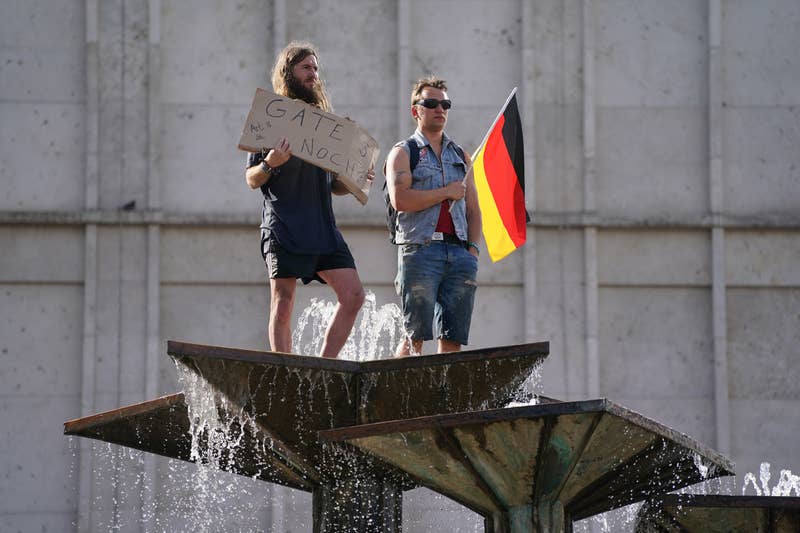
Sean Gallup / Getty Images
Two protesters, one holding a sign referencing Bill Gates, the other a German flag, stand on a water fountain during a protest rally in Berlin against coronavirus lockdown restrictions, May 9.
In early May, a little over 100 people met on the steps of the state Parliament building in Melbourne, Australia, and chanted "arrest Bill Gates." One speaker at the protest, Fanos Panayides, runs a Facebook Group called "99% unite Main Group 'it's us or them,'" which since he started it on April 8 has grown to more than 37,000 members who have made more than 900,000 posts, comments, and reactions, according to social media analytics site CrowdTangle.
Anti-Gates signs have appeared over the last month in Long Island; London; Nottingham, England; and Annapolis, Maryland. Gates was also the focus of a violent anti-COVID-19 lockdown protest in Germany over the weekend.
Conspiracy theories have also appeared on Indian social media. Drawing on a false claim that dates back to at least 2014, Health Impact News, a pseudoscience website that promotes conspiracy theories about 5G and vaccines, claimed on May 19 that the Bill & Melinda Gates Foundation had been sued and “put on trial" before the Supreme Court of India regarding the deaths and injuries caused by trials of Gardasil, the HPV vaccine. One version of the claim featured a photo of Gates and Dr. Anthony Fauci together with text that read, “Well, well, well, Globalist population control Bill Gates shortly after his trip to India with Dr. Fauci.”
Although there was in reality no lawsuit, there really was a study in India funded by the Gates Foundation. In 2010, the trials, conducted by the Program for Appropriate Technology in Health, was canceled after local media reported that seven girls had died after taking part in it. Investigations carried out by the Indian government determined that the deaths were unrelated to the vaccine.
So when Cunial stood up in the Italian Parliament last week and demanded Gates be arrested for “crimes against humanity," it wasn’t random. It was a crossover win for the COVID-19 conspiracy theorists. Amid heckles and jeers, Cunial called upon other Parliament members to defy any plans for a compulsory vaccination against COVID-19.
Cunial is a former member of the Five Star Movement (M5S), an antiestablishment party that won the most seats in Italy's 2018 general election. Her Facebook page is full of anti-vax, anti-5G, and COVID-19 misinformation. She’s also a supporter of the ID2020 microchip theory: the belief that the ID2020 Alliance, a nongovernmental organization that advocates for digital IDs for undocumented people and refugees, is working with Gates to build a surveillance state with tracking devices in the COVID-19 vaccine.
She’s far from the only anti-vaxxer among the M5S or its former members. The party campaigned on objections to vaccinations. Observers of Italian politics have argued that vaccine skepticism is one of the central tenets of what M5S stands for.
A member of the Italian Chamber of Deputies condemned Cunial’s “absurd and unfounded theories” on Twitter, but, her speech was nevertheless seized on by Russian state media, amplified by the American far right, and shared in various ways on Facebook and YouTube.
Two versions of Cunial’s speech were removed on Thursday by YouTube after they were flagged by BuzzFeed News. YouTube spokesperson Farshad Shadloo said the videos violated the site's policies around medical misinformation.
“We’re committed to providing timely and helpful information at this critical time, including raising authoritative content, reducing the spread of harmful misinformation, and showing information panels, using CDC data, to help combat misinformation,” Shadloo said. “We have clear policies against COVID misinformation, and we quickly remove videos violating these policies when flagged to us.”
A scan of the YouTube comments about Cunial will make you wonder how to untangle the confusion. A report from RT about Cunial’s speech was shared on Tuesday to “X22 Report [Geopolitical],” one of the larger QAnon Facebook Groups.
“Ironically fact checker blocked this earlier on me. ... It's literally what they say. It's ridiculous,” one user wrote, referring to the fact that Facebook’s third-party fact-checkers have flagged several versions of Cunial’s video as “partly misleading.”
“The fact checker and Politifact is owned by Gates and Soros, so you won't know the truth,” another commenter erroneously replied, going on to call down a curse on them in ornate language: “But hell be their homes and what they fear the most on earth be their torment 1000 times over for eternity.” ●
MORE ON THIS
These Are The Fake Experts Pushing Pseudoscience And Conspiracy Theories About The Coronavirus Pandemic
Jane Lytvynenko · May 21, 2020
Ryan Broderick · May 14, 2020
Tasneem Nashrulla · May 14, 2020

Ryan Broderick is a senior reporter for BuzzFeed News and is based in New York City.













